Many low light indoor plants are conveniently easy-care and virtually indestructible! So they make great choices for the beginner or someone who’s too busy to fuss over plants every day!
They’re useful for spots in the home or office that don’t have bright light streaming in through the windows. Low light house plants can spruce up a bathroom, the kitchen, or bedroom with a bit of color and visual interest
Let’s start with some clarification: “low light” doesn’t mean no light. All plants need some amount of light to thrive. So a low light houseplant can’t be put in a dark corner where it can’t get any light!
Understanding Low Light Conditions
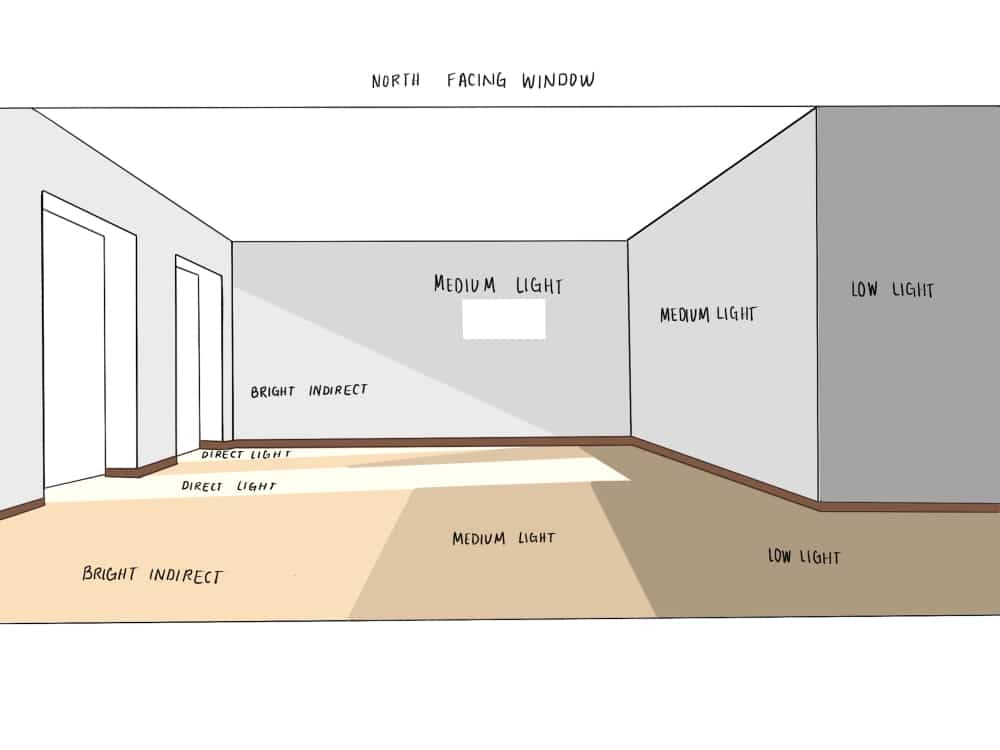
Just as you need to think about how much direct sun hits different spots in your garden when you’re choosing outdoor plants, you need to pay attention to the sunlight shining in through the windows of your home. This helps you choose what plants to grow indoors – and where to put them in your home or office.
Light for plants – whether from the sun or grow lights – is about both intensity (how strong the light is) and duration (how many hours). Both of these affect the growth rate and flowering of a plant (not all houseplants produce flowers).
Light intensity and duration are both affected by the time of year (vary from season to season), the location/size of windows in a room, and the exact spot in a room you place a plant.
Summer vs Winter
In the summer, the sun is higher in the sky and might not shine very far into a room through a window. In winter, on the other hand, the sun is lower in the sky and direct sunlight through a window may reach further into a room.
If there’s a deciduous tree outside the window, its leaves will cast shade across the window in the summer but then let in more light in winter when it has dropped all its leaves.
So, in winter, a room will probably get more direct sunlight but the light won’t be as intense as summer sunlight.
Most houseplants – with one or two exceptions – generally don’t like strong direct summer sunlight, but can tolerate direct winter sunlight. Low light plants sitting across from a window will get a bit more light in the winter.
Location Of Windows
The amount of sunlight reaching different spots in a room depends on the size and location of windows.
Most indoor plants like sunlight that’s described as “bright indirect” light. This kind of light can be found about 5 feet (1.5 meters) in from a window that gets direct sun for part of the day.
Low light plants, on the other hand, can be placed further away from a window. Once you get 5-8 feet (1.5 – 2.5 meters) back from a brightly-lit window, the intensity of the light decreases by about 95%. This is the low-light zone for houseplants. Any further than that from a window, and the light intensity won’t be strong enough to support plant growth.
If there are large windows on opposite walls, the whole room may get bright indirect light (other than the walls directly to either side of the windows). In this case you could put low-light plants on a table in the center of the room.
How Much Light Is “Low Light”?
As we’ve discussed, the light in a room decreases as you move back from a window. A low-light spot will get no direct sunlight from a window but will still get enough natural light for you to comfortably read a newspaper for several hours in a day. Any less light than that is considered too dark for a plant to grow well without the addition of artificial lights (see below).
The paint color on the walls and ceiling of a room also affects the brightness of the light throughout the room. Lighter paint colors like white or cream will reflect whatever light comes in through the windows, and brighten up darker corners.
Interior designers will be familiar with the trick of adding a large mirror to a dark wall across from a window to brighten up a room. This can also benefit the houseplants!
Low Light Plants For Specific Spaces

Best Low Light Plants For Apartments
Choose more compact low light plants for small apartment spaces such as peace lilies.
There are plenty of low-light (shade) spots in your apartment to put houseplants (ones that like low light, that is!). You’ll find these spots in front of a window that doesn’t get direct sun, like a north-facing window or a window shaded by a tree outside.
Other low-light locations are those 5-8 feet (1.5 – 2.5 m) across the room from windows that get direct sun.
If you have a room with windows on opposite walls, the center of the room is a good low-light spot. You could feature a collection of low-light plants on a small table to divide the room or behind a couch.
If you have a set of tall shelves against the wall beside a window, you could place a trailing plant in a pot on top of the shelves. The plant could then trail down the side of the shelves, getting light from the side of the window.
Low Light Plants For Offices
Office environments often have lots of areas of low light, set well back from windows. Some workplaces also have enclosed offices with no natural light at all.
The areas set back from windows may get sufficient light for low-light plants. Enclosed offices won’t. However, there’s good news! Workplaces also have plenty of artificial lighting, usually in the form of fluorescent ceiling lights, or the more energy-efficient LED lighting.
These artificial light sources provide sufficient light to support the growth of low light plants. They’re like built-in plant lights! The lights will need to be on for 12 hours a day every day.
So if you’re thinking about buying low light plants for an office setting, there are plenty to choose from to brighten up the space. Some are small enough to sit on a desk, while others are nice and tall to put on the floor in a reception area, such as a ZZ plant.
Some low light plants have excellent oxygen-producing and air-purifying capabilities. Increased oxygen levels and clean air helps you work better. There are office-friendly plants that boost productivity such as peace lilies and spider plants.
Low Light Plants For Bedrooms
As we know, plants absorb carbon dioxide and release oxygen through photosynthesis, however, their benefits extend beyond oxygen production.
Some plants, such as spider plants, peace lilies, and snake plants, also absorb harmful toxins like formaldehyde, benzene, toluene, and xylene from the air.
Most plants release oxygen during the day, but some varieties, such as the Snake Plant, continue this process throughout the night. So it is a great choice in the bedroom for improved air quality while you sleep.
Low Light Indoor Trees For Spacious Areas
Consider the Dragon Tree or Parlor Palm if you’re looking for a house plant tree for larger areas or for low light corners.
If there’s a particular spot you’d really like to put a houseplant, but the location is too dark (such as a hallway or empty corner in a room), consider adding a plant light to provide artificial light for the low light corner. These lights are either fluorescent or LED, as lighting tubes or individual bulbs.
These lights can work for large indoor plants for low light corners. There are lots of options to suit different settings and home decor, whether you want one for a small table-top plant or to provide lighting for a six-foot house plant palm tree.
Top 10 Best Low Light Houseplants
Most houseplants are native to humid tropical regions, where they grow under a tall canopy of trees. So they don’t like direct sunlight. Still, they need enough light for photosynthesis (the chemical process of plants making their own food in their leaves from carbon dioxide and water in the presence of sunlight). Flowering plants need even more light to produce their flowers.
So, most of the plants in the following list – with the occasional exception – are interesting foliage plants that don’t produce flowers.
1 – Snake Plant or Snakeskin Plant (Sansevieria sp)
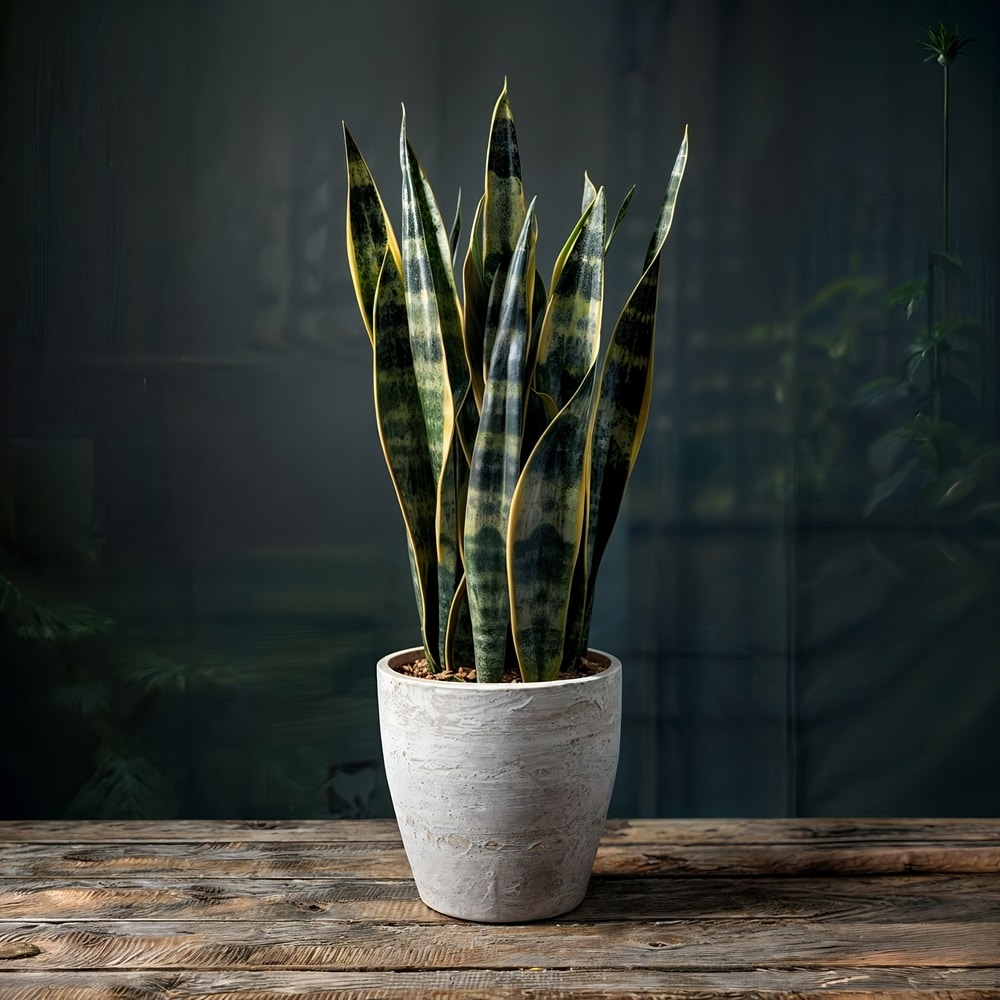
Snake plants are a popular choice for low light spaces. They’re almost indestructible, tolerant of dry indoor air, mild drafts and short periods of drought and also a great choice for improving indoor air quality. they can grow quite happily when rootbound, so they don’t need frequent repotting. They are sensitive to are over-watering or long exposures to temperatures near freezing.
There are several different varieties of snake plant. There are short ones with fleshy leaves, perfect for an office desk or small apartment. Others have tall slender stiff foliage. The tall snake plant varieties are perhaps the most familiar. They add a touch of elegance and drama to a room, with their tall erect forms. They make a statement in an entryway or an office waiting room.
All varieties have the classic wavy horizontal stripes that give the plant its common name. Some have yellow edges, others have blue-green silvery leaves.
Certain varieties are more tolerant of low-light conditions than others, so care should be taken when selecting which to buy.
| Origin | West Africa |
| Plant size | 12 to 48 inches (30 to 120 cm) tall; can spread 12 to 24 inches (30 to 60 cm) wide |
| Flowering | N/A |
| Light | Bright indirect sun, can tolerate low light |
| Watering | Allow to dry out slightly between waterings in spring and summer. Water less in winter. Avoid wetting the centre of the plant |
| Fertilizer | Feed every 6 weeks in spring and summer. Can tolerate little fertilizer |
| Potting soil | Well-draining potting mix; cactus or succulent mix works well |
| Pruning | Remove dead leaves |
| Repotting | Seldom required |
| Toxicity | Toxic to pets and people if ingested |
2 – ZZ Plant (Zamioculcas zamiifolia)
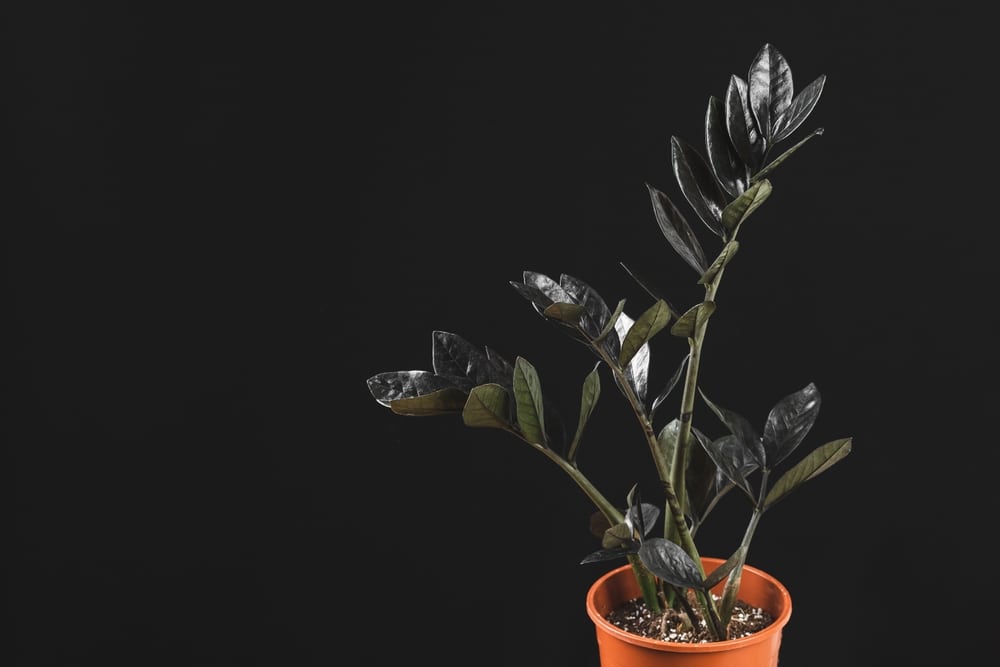
The ZZ plant is a slow-growing plant with stiff stems and thick dark green shiny leaves that grow opposite each other up the stem. It has an upright stiff appearance. The leaves are so glossy it is sometimes mistaken for an artificial one!
The ZZ plant can grow in a range of different conditions. It’s drought-tolerant and can store water for several weeks in its rhizomes (fleshy underground stems). It only needs watering when all the soil in the pot has dried out completely. So it’s a great choice for those of us who tend to forget to water our houseplants – or for office spaces where they often get neglected!
They’re fussy about temperature, though, so be sure to place it well away from cold winter drafts or the blast from indoor air conditioners in the summer.
ZZ plant is known for its ability as an air purifier. It’s efficient at removing toxins such as xylene and benzene from the air.
| Origin | Eastern Africa |
| Plant size | 2-4 feet (60 – 120 cm) tall and wide, sometimes more |
| Flowering | Rarely flowers as a houseplant |
| Light | Adaptable, bright to low-light |
| Watering | Allow soil in whole pot to dry out completely between waterings, then water deeply to moisten |
| Fertilizer | Regular feeding not required. Apply fertilizer, diluted to half recommended strength, twice during the summer growth period |
| Potting soil | Well-draining |
| Pruning | Remove bottom leaves as they age |
| Repotting | Refresh the soil every two or three years in same size pot or use slightly larger pot |
| Toxicity | Toxic to humans and pets |
3 – Peace Lily (Spathiphyllum)

Peace Lily is a low-light plants that flower. It’s a good low-maintenance houseplant with glossy green leaves and white flowers called “spathes” shaped like the cupped palm of a hand. They’re easy to grow and fairly trouble-free.
They will grow in low-light conditions, but flower better in bright indirect light. When they flower, each flower lasts a few weeks. If your peace lily hasn’t flowered, either it is a young plant or it’s getting too little light.
The biggest mistake to make when growing a peace lily is over-watering. They like their soil moist, but don’t over-do it!
| Origin | Southeast Asia and Central America |
| Plant size | Typically 12 to 36 inches (30 to 90 cm) tall; can spread 12 to 24 inches (30 to 60 cm) wide |
| Flowering | White spathes. Can flower year-round under the right conditions |
| Light | Can tolerate low light. Avoid direct sunlight |
| Watering | Keep soil evenly moist. Water when the top inch (2.5 centimeters) of soil has dried out. Reduce watering in winter |
| Fertilizer | Feed every 6-8 weeks during the spring and summer |
| Potting soil | Well-drained potting mix |
| Pruning | Remove yellow leaves and spent flowers |
| Repotting | Repot every 1-2 years |
| Toxicity | Toxic to pets and humans if ingested |
4 – Cast Iron Plant (Aspidistra elatior)
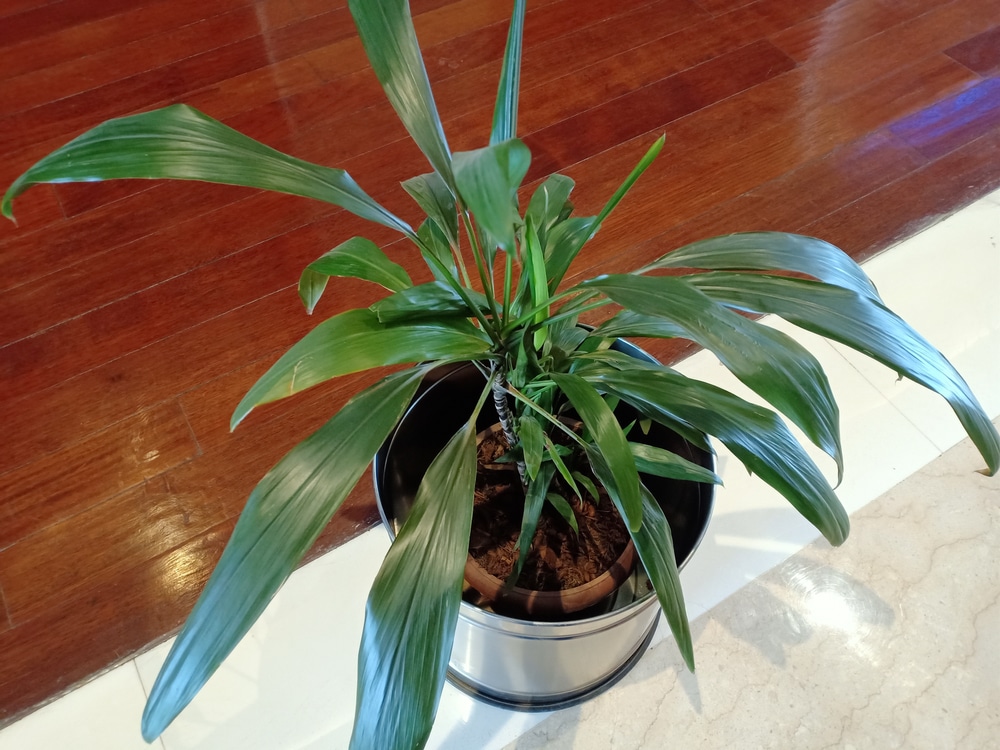
This has long been a popular houseplant. Its common name “cast iron plant” comes from its tolerance of neglect. It can survive periods of drought at cooler temperatures, and unlike most houseplants it can put up with low humidity. The two things most likely to kill it are over-watering and too-frequent repotting.
Definitely a good choice if you’re looking for something low-maintenance for your home or for an office where they often get forgotten!
Cast iron plants have long lance-shaped leaves, 24 inches (60 centimeters) long and 4 inches (10 centimeters) wide. Each leaf grows directly from the soil, emerging rolled into a tube that gradually unfurls. There are several varieties, some with stripes, some with white leaf tips, and one with yellow speckles all over the leaves.
They can tolerate low-light conditions but grow better with medium to bright light (but not direct sun). These plants benefit from occasional washing of foliage. Simply wipe the leaves with a damp cloth.
| Origin | China and Japan |
| Plant size | 2-3 feet (60-90 cm) tall and 1-2 feet (30-60 cm) wide |
| Flowering | Rarely flowers as a houseplant |
| Light | Medium to low light |
| Watering | Allow soil to dry out between waterings then water deeply |
| Fertilizer | Apply all-purpose water-in fertilizer once a month in spring and summer. Apply slow-release fertilizer once in spring |
| Potting soil | Well-draining |
| Pruning | Cut out dead leaves at base |
| Repotting | Infrequently, every few years, in spring, when roots grow out of the pot’s drain holes |
| Toxicity | Not toxic to people or pets |
5 – Pothos, Devil’s Ivy (Epipremnum aureum)
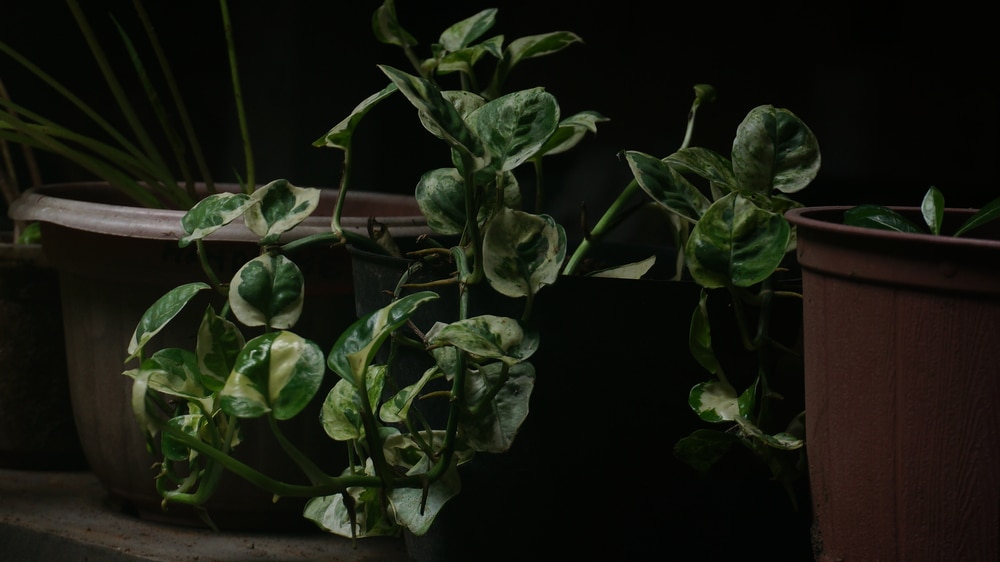
Pothos is one of the best plants for beginners. It’s an easy care and adaptable to varying conditions. Pothos plants have thick heart-shaped leaves growing singly on long stems along a trailing main vine.
Pothos are great trailing plants for low-light conditions. They can be left to trail down from the top of a shelf or trained up a trellis or other support. They’re often found on an office desk or in a college residence room with the trailing vine trained up and across the top of a window.
There are several different varieties, many with interesting variegated leaves of yellows or creamy white and green. If the light conditions are too low, however, the plant will lose its variegation and revert to all-green.
| Origin | French Polynesia |
| Plant size | 20 to 40 inches (50 to 100 cm) long; can trail much longer |
| Flowering | N/A |
| Light | Indirect sun; can tolerate low light |
| Watering | Water when the top inch (2.5 centimeters) of soil has dried out |
| Fertilizer | Feed every 4-6 weeks during spring and summer |
| Potting soil | Well-drained potting mix |
| Pruning | Trim long stems to encourage bushier growth;remove yellowing leaves. Pinch off growth tips to encourage bushier growth |
| Repotting | Repot every 1-2 years |
| Toxicity | Toxic to pets and humans if ingested |
6 – Heart leaf philodendron, Sweetheart plant (Philodendron scandens)
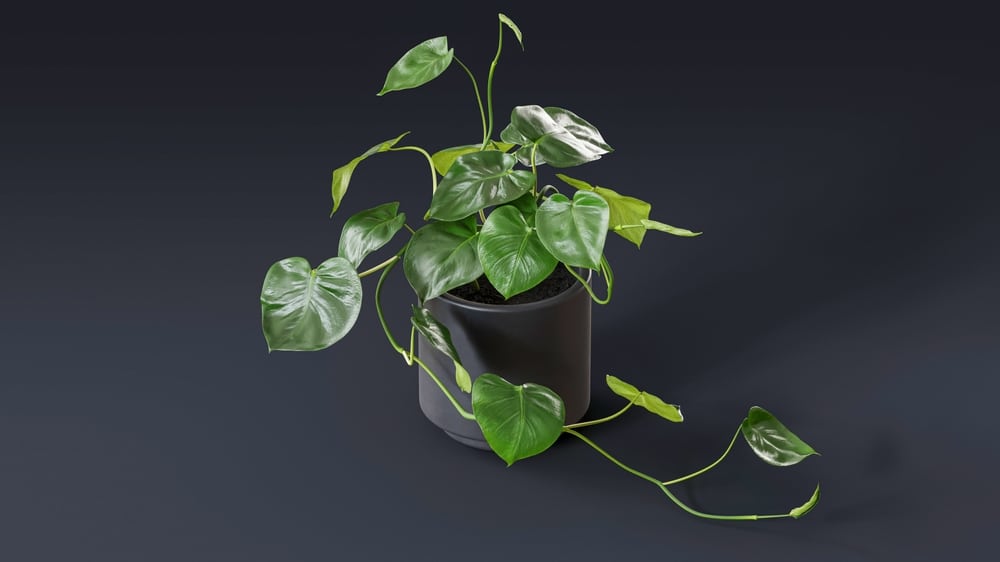
The heart leaf philodendron is another great one for beginners. It’s tough as nails, tolerating a range of conditions and some degree of neglect. It can grow in low-light conditions but will grow fuller and faster with bright light.
The heart leaf philodendron is a trailing plant with heart-shaped leaves, similar to pothos. The leaves are a dark green but when they first grow in, they have a bronze coloration.
If you want a fuller plant, pinch off the growth tips to encourage bushy side growth. They grown with too little light will have smaller and fewer leaves more spaced out along the main trailing stem.
Heart leaf philodendron is a slow-growing but long-lived plant.
| Origin | Central and South America |
| Plant size | 12-24 inches (30-60 centimeters) in height; can trail or climb up to 3-4 feet (90-120 centimeters) |
| Flowering | N/A |
| Light | Bright indirect sun, can tolerate low light |
| Watering | Water when the top inch (2.5 centimeters) of soil has dried out. Avoid overwatering |
| Fertilizer | Feed every 4-6 weeks during spring and summer |
| Potting soil | Well-drained potting mix |
| Pruning | Trim any leggy growth and remove any yellow or damaged leaves |
| Repotting | Repot when root-bound, about every 2-3 years |
| Toxicity | Toxic to people and pets if ingested |
7 – Chinese Evergreen (Aglaonema modestum)
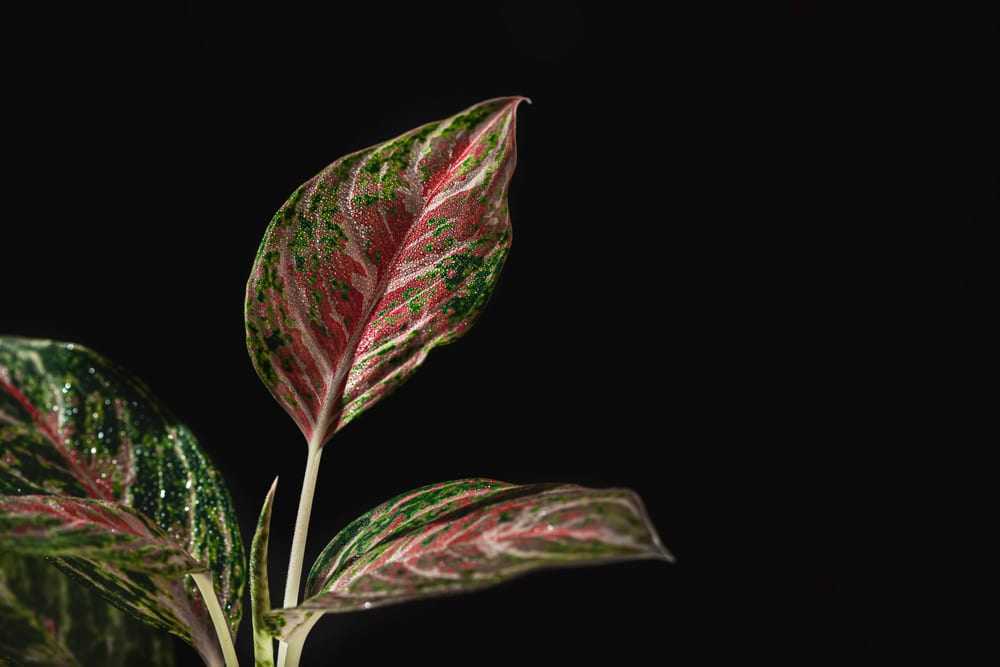
The Chinese evergreen is known for tolerating low-light conditions. There are several varieties, some with interesting variegated leaves and others with vibrant pink coloration. However, the colored and variegated varieties need more light (to maintain their coloration) than the all-green variety, Aglaonema modestum.
Chinese evergreen plants have long lance-shaped leaves on short stems that grow from the base.
It is slow-growing and needs regular feeding but infrequent repotting.
| Origin | Southeast Asia |
| Plant size | Typically 12 to 36 inches (30 to 90 cm) tall; can spread 12 to 24 inches (30 to 60 cm) wide |
| Flowering | N/A |
| Light | Tolerates low light |
| Watering | Water when the top inch (2.5 centimeters) of soil has dried out |
| Fertilizer | Feed every 4-6 weeks during spring and summer |
| Potting soil | Well-drained potting mix |
| Pruning | Remove yellow leaves. When stems get leggy, cut back to a leaf node a few inches above soil level. |
| Repotting | Infrequently, 2-3 years |
| Toxicity | Toxic to pets and humans if ingested |
8 – Parlor Palm, Dwarf Mountain Palm (Chamaedorea elegans)
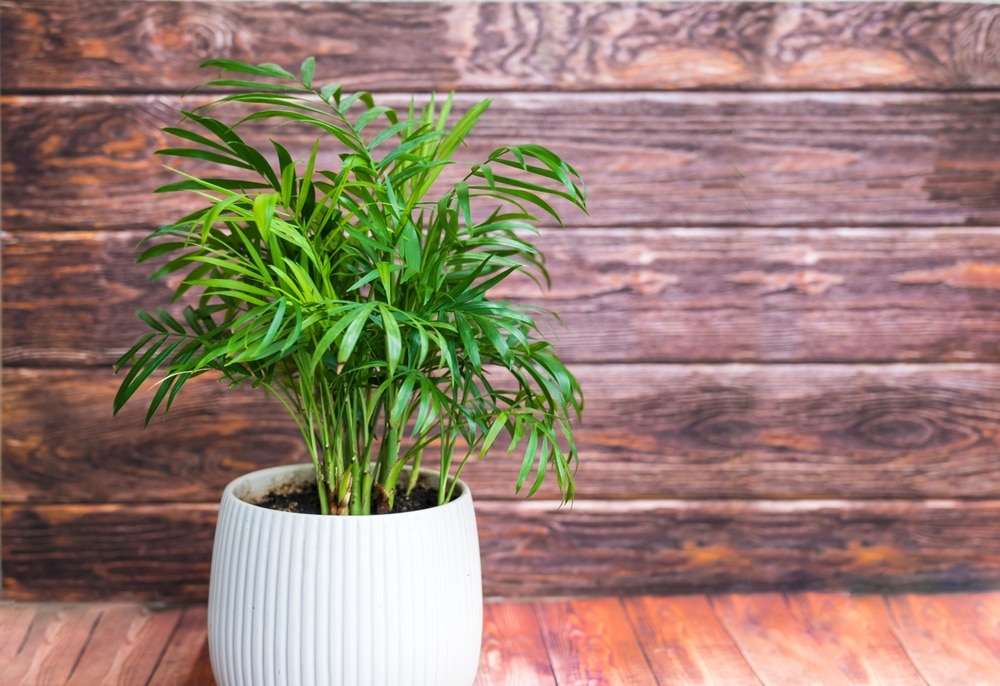
The Parlor palm is one of the most popular palms to grow indoors. Its popularity as a houseplant dates all the way back to Victorian times, when it was used to add elegance to the parlor (the room to entertain guests). Hence its common name.
Parlor palm is easy-care with long, arching divided leaves with pairs of smaller leaflets growing in opposite pairs along the main midrib. These midribs look like long arching stems growing from the soil. As it matures, it develops a short woody trunk.
Parlor palms grow up to 6 feet (2 meters) tall as a houseplant. But they’re very slow-growing, so if you want something tall to fill a space right away, you’ll need to buy one that’s already close to the height you want.
These small trees add a tropical feel to a room and like good humidity. Mist frequently—especially in winter—with a spray bottle on mist setting.
A good spot to put a Parlor palm is beside a north-facing window.
| Origin | Mexico, Guatemala |
| Plant size | 2-6 feet (6-2 m) tall x 2-3 feet (60-90 cm) wide |
| Flowering | Rarely blooms indoors |
| Light | Prefer bright indirect light but can adapt to lower-light conditions |
| Watering | Keep soil evenly moist in summer. In winter, water sparingly when the top third of soil has dried out |
| Fertilizer | Apply all-purpose liquid houseplant fertilizer in summer, diluted to half the recommended strength |
| Potting soil | Peat-moss based mix |
| Pruning | Remove lower leaves as they turn brown with age |
| Repotting | Only necessary when roots have completely filled the pot |
| Toxicity | Not toxic to people or pets |
9 – Dragon Tree (Dracaena marginata)
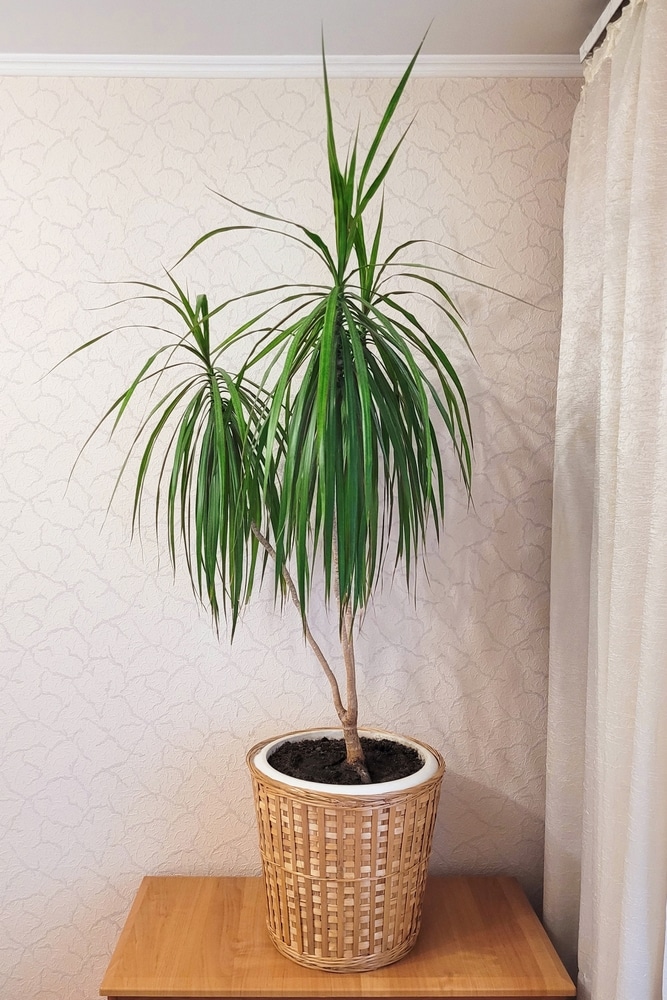
There are several different varieties of Dracaenas. Depending on the variety, they tolerate a range of light levels, from bright indirect to low light.
One of the best for low-light conditions is Dracaena marginata, the Madagascar Dragon Tree.
The Dragon tree is an easy-to-grow and slow-growing. It has long narrow red-edged green leaves growing densely from a central stalk or stem. When purchased, there will usually be multiple stems in a pot.
The lower older leaves will eventually drop off as new leaves grow in at the top. Eventually it develops a tree form, with a thin trunk and greenery growing from the top.
If your Dragon tree gets too tall for your space or looks too naked at the base, you can prune it back to encourage bushier growth. In the spring, cut the stalk just above an old leaf node at whatever height you choose. Soon new side shoots will grow and develop into new tall stalks.
When watering the Dragon Tree, it’s best to use distilled or non-fluoridated water (or rain water). These plants are sensitive to fluoride and other salts in tap water, which can turn the leaf tips brown and crispy. It is similarly sensitive to too much fertilizer.
Dragon tree is one of the plants NASA used in its study of plants that can clean the air. It was found to be effective at removing formaldehyde and benzene pollutants from the air.
| Origin | Madagascar |
| Plant size | Up to 6 feet (2 m) tall |
| Flowering | N/A |
| Light | Bright indirect, but can tolerate low-light |
| Watering | Allow top half of soil to dry out between waterings, then water deeply |
| Fertilizer | Sensitive to fertilizer. Apply all-purpose liquid houseplant fertilizer at half recommended dilution once a month in spring and summer |
| Potting soil | Well-draining |
| Pruning | Not usually necessary |
| Repotting | Infrequently. Every 3-4 years |
| Toxicity | Very toxic to pets; harmless to humans |
10 – Spider Plant, Ribbon Plant (Chlorophytum comosum)

Spider plants are the classic beginner’s houseplant. They are also one of the best choice for low-light conditions.
They’re really easy to grow and generate lots of new baby plants, making propagation easy. Although, that can sometimes be too much of a good thing (like growing zucchinis!).
Spider plants have grassy ribbon-like leaves that form an attractive arching clump. The leaves are 6-12 inches (15-30 centimeters) long, sometimes with creamy white or light yellow central stripes.
In spring and summer, clusters of small white start-shaped flowers are produced along long wiry yellow stems that arch and hang down 2 feet (60 centimeters) below the foliage. Each flower cluster is then followed by a miniature clump of leaves. Eventually these clumps develop nubby roots. Once roots develop, a clump can be cut from the parent plant and potted individually to grow into a new one.
These small clumps on their long arching stems are what give spider plants their character and visual interest. They’re also what gives the plant its common name, not because they attract spiders to your home!
Spider plants are easy-care and can put up with some neglect. They like to have evenly moist soil, but can survive periods of drought. As it ages, it develops fleshy rhizomes (underground stems) that can store water, making it tolerant of inconsistent watering.
Because of their long flowering stems, they do best as a hanging display. Or sitting on a tall pedestal stand, to allow their trailing stems to cascade down like a fountain.
| Origin | South Africa |
| Plant size | 12-24 inches (30-60 cm) in height, with a similar spread |
| Flowering | Flowers in spring and summer |
| Light | Prefers bright, indirect light but can tolerate low light |
| Watering | Water when the top inch (2.5 centimeters) of soil feels dry; avoid overwatering. Reduce watering in winter |
| Fertilizer | Feed monthly during the growing season (spring and summer) with a balanced, water-soluble fertilizer |
| Potting soil | Well-draining potting mix, such as a mix for houseplants |
| Pruning | Trim off brown tips and dead or damaged leaves to maintain appearance and promote new growth |
| Repotting | Repot every 1-2 years or when the plant becomes root-bound; typically done in spring |
| Toxicity | Non-toxic to pets and humans |
How To Care For Low Light Houseplants
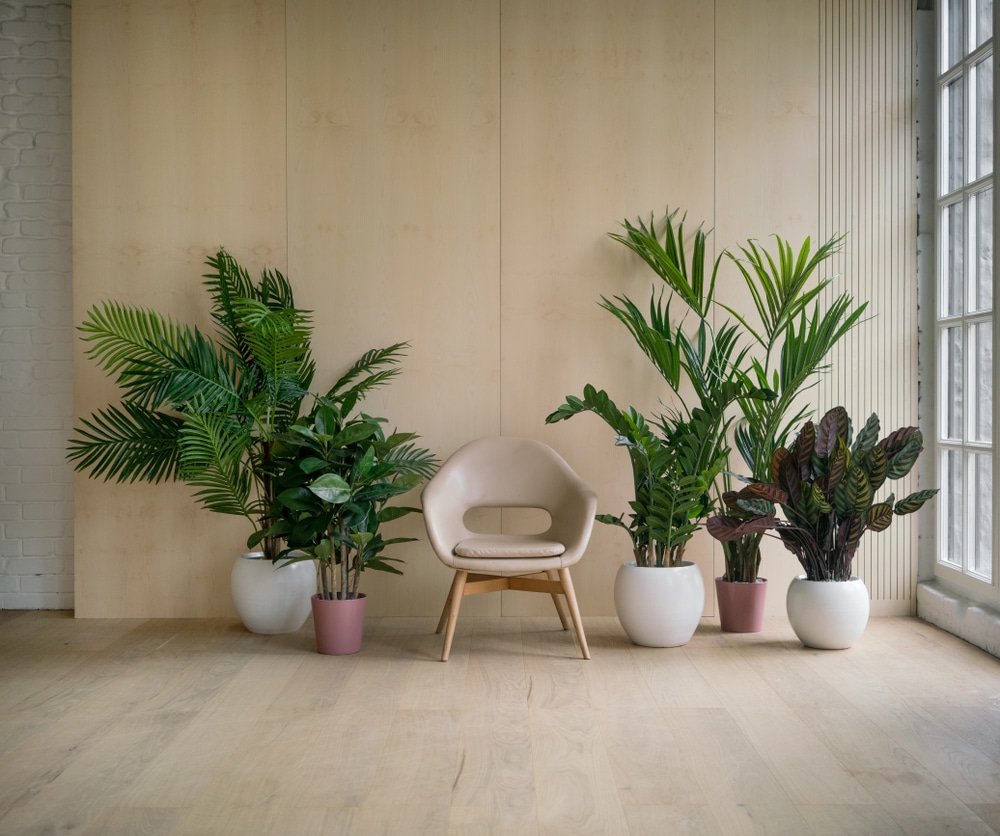
Every plant has its own maintenance requirements. So it’s important to get to know the specific needs of each of your houseplants; they won’t all be the same.
“Those that grow in low light conditions generally grow more slowly than those in brighter light. As a result, they generally need less watering and fertilizer. Most of them are relatively easy-care, requiring little in the way of pruning.
Refer to the above information tables for more specific details on how to care for each one of them.
Common Problems And How To Solve Them
Indoor plants of all sorts suffer from common challenges. Some are caused by environmental conditions (e.g. dry air, low light, too much water, not enough nutrients). Others are the result of insect pests or disease.
The biggest mistakes commonly made with low-light plants are over-watering and over-fertilizing. Because they’re in low-light conditions, they tend not to grow as vigorously as those in brighter light. So, they’ll use less water and need fewer nutrients.
See below for some troubleshooting tips on common problems.
Environmental
| Sign | Problem | Solution |
|---|---|---|
| Droopy-looking leaves | Too much water / Too little water | For most plants, water when top 1 inch (2.5 centimeters) is dry |
| Leaves with brown tips | Too dry / Too much fertilizer | Use a spray bottle to mist plant. Reduce feeding. Mix half the concentration and use it twice as often |
| Yellow leaves | Watering issue / Not enough light | Water when top 1 inch (2.5 centimeters) is dry. Relocate to a position of bright indirect sunlight |
| Bottom leaves yellow | Lack of Nitrogen (N) | Apply a houseplant fertilizer to provide some nitrogen |
| Yellow leaves on one side | Too much sun | Relocate plant out of direct sunlight |
Pests
| Problem | Signs and Symptoms | Solution |
|---|---|---|
| Spider Mites | Leaves turn speckled yellow (like spray paint), dry up and curl. Fine webs are visible on underside of leaves and on growth tips. Tiny mites are barely visible crawling on underside of leaves and in webbing | Wipe down all leaves with damp cloth. For severe cases, apply a commercial insecticidal soap product. Spray undersides of leaves and wherever there are webs.To prevent infestations, maintain high humidity around plants. |
| Aphids | New shoots and young leaves curl & turn yellow. Leaves may be covered with sticky coating.Aphids will cluster on new growth tips | For mild cases, wipe plant parts to squish aphids. Repeat every few days.For heavy infestations, prune off plant tips. Apply a commercial insecticidal soap product, spraying directly onto aphids. |
| Mealybugs | Leaves curl and turn yellow. Cotton-like white tufts are visible on underside of leaves and at leaf nodes on the stems | Using a cotton swab dipped in rubbing alcohol, carefully dab the clusters of insects. Apply a commercial insecticidal soap product. Spray directly on fluffy clusters. |
| White fly | Tiny white moth-like flies flutter around when plant is disturbed.Mottled yellow leaves with distorted growth. Sticky honeydew on foliage. | Hang yellow sticky-trap cards (one or two cards per plant) around infested plants at first sign of white flies to trap adults. Apply a commercial insecticidal product listed for white fly. Flies must be sprayed directly to be effective and repeat applications are usually necessary |
| Soft brown scale | Young leaves are pale and stunted. Scales are found on stems and along the centre vein on the underside of leaves.Black sooty mold may appear on leaves | Wipe scale off leaves and stems using a cotton swab dipped in rubbing alcohol. |
| Soil Gnats | Don’t pose a problem for plant health but can be a nuisance flying around plants | Allow top two inches (5 cm) of soil to dry out between waterings. Cover the soil surface with a half-inch (2 cm) layer of coarse sand or kitty litter |
Decorating With Low Light Plants

Incorporating low light plants into your home decor can add a refreshing touch and bring life to any space. Here are some styling tips to help you arrange them effectively!
Styling Tips: How To Arrange Low Light Plants In Your Home
When arranging low-light greenery, consider the height, shape, and texture of each one. Grouping them at different heights can create a visually appealing display.
For example, position taller varieties like a Parlor Palm at the back of a shelf or in a corner, while shorter ones like Peace Lilies can be placed in front or on a table. Using stands can also add dimension and elevate your greens, making them stand out even more.
Pots And Containers For Low Light Indoor Plants
Choosing the right pots and containers can enhance the aesthetic of your low light plants.
Opt for pots that complement your decor style, ceramic pots add a touch of elegance, while colorful or textured containers can make a bold statement.
Don’t forget to consider drainage. Ensure that your pots have holes to prevent water from accumulating, which can be detrimental to plant health.
Combining Low Light Plants With Other Indoor Garden Elements
To create a cohesive indoor garden look, consider combining your low light varieties with other natural textures like wood or stone to bring a bit of the outdoors in.
Additionally, grouping greenery with similar care needs in a dedicated nook or on a shelf can create a mini jungle effect, making your space feel vibrant and lush.
FAQS
Can Low Light Plants Survive In No Light At All?
No! All indoor plants need some level of light to survive.
Do Low Light Plants Need Fertilizer?
Generally, low light plants grow less vigorously than plants in brighter light. So they don’t need fertilizer as often. How much and how often depends on the type of plant.
What Are The Best Low Light Plants For Beginners?
Most low-light varieties are easy to care for. Some of the best options for beginners include Snake plant, Cast iron plant, Pothos, and Spider plant.
How Often Should You Water Low Light Indoor Plants?
How often you water an indoor plant—regardless of how much light it receives—will depend on the season and the growing conditions, as well as the type.
See the information tables for more specific details on each species’ requirements.
Safety Considerations For Pets And Children
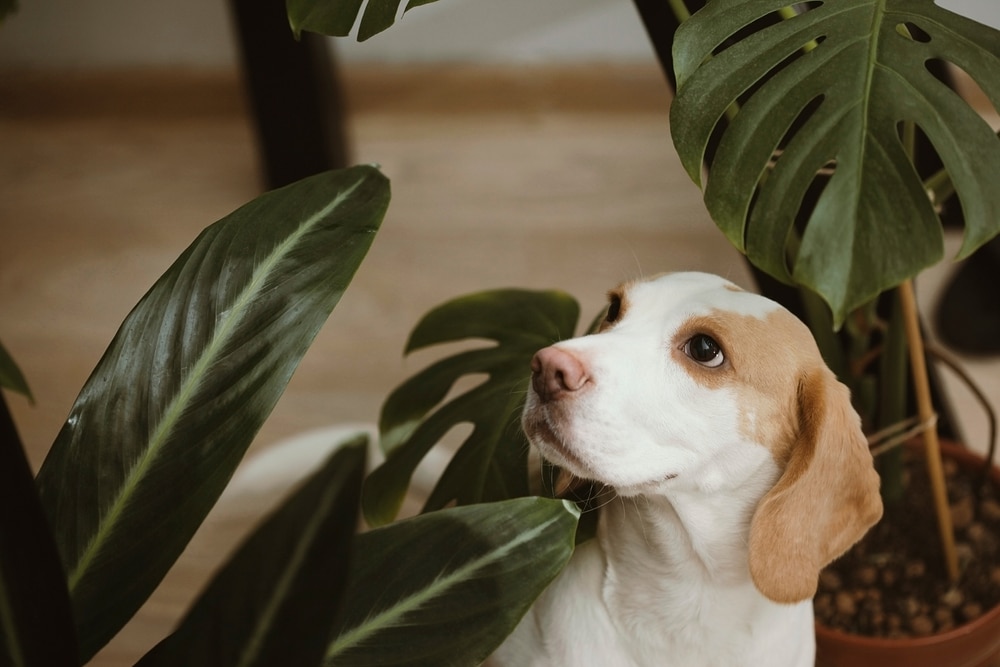
At Gardenia Organic, we strive to provide helpful information on a variety of plants and their benefits. When incorporating any of them into your home, it’s important to consider the safety of your pets, as some can be toxic if ingested
For the health of your pets (and plants!), we suggest locating your houseplants in locations that are less accessible to curious animals.
While we offer guidance and information, we encourage you to research each plant’s safety so you can make informed decisions. Always monitor your pets around houseplants, take precautions to ensure their well-being, and consult with a veterinarian if you have any concerns.
Naturally, the same cautions apply in homes with small children, who are often drawn to the colors and shapes of indoor greenery. Keep these out of reach of curious little hands. If you’re unsure about having them in your home, consult your family doctor.
Your family’s safety is our priority, so do some research and educate yourself about each plant’s possible risks. Then you can enjoy your indoor greenery while keeping your children and pets safe and happy.
Where To Buy Houseplants
There are lots of places you can go to find them. Garden centers and florists would be my first stop, and then grocery stores with a floral and houseplant section.
You can also find them in the garden centers of hardware stores and “big box” stores. I’m more wary of these sources, though. Often they don’t have dedicated – or knowledgeable – staff to properly maintain their houseplants. As a result, they become more stressed the longer they sit in the store and by the time you buy them, they’re already struggling.
You can also buy them online, but I prefer to purchase mine in person. At garden centers and florists, you can find someone knowledgeable who can answer your questions and help you choose the right options for your conditions. You can also examine them before buying (see tips below).
When you shop online, you don’t really know what you might be getting. Plus, shipping can put a lot of stress on a plant, so you don’t know what condition it will be in when it arrives on your doorstep. If you’re looking for rare and unusual varieties, though, online sources might be your only option.
Tips For Buying Houseplants
When shopping in person, it’s important to be sure the plant you’re buying is healthy and in good condition.
Here are some things that I recommend you look for:
Healthy Foliage
Look for leaves that are nice and green, no pale yellow patches or edges (unless the plant is supposed to be multi-coloured!) There should be no dead dry brown tips or spots on the leaves. Be sure the leaves aren’t soft and droopy-looking. Also look for healthy new growth coming in at the tips or base of the plant.
No Sign Of Pests
Check the leaves and stems closely for any sign of insect pests. Pick up the plant and see if any insects fly away (possibly thrips or soil gnats).
Look for very fine webbing on the underside of leaves and where the leaves attach to the stem (sign of spider mites).
Check for things that look like small dabs of cotton wool on the underside of leaves or where the leaves attach to the main stem (sign of mealybugs).
Roots Coming Out The Drain Holes
When a plant’s roots run out of room in a pot, it is rootbound (or “pot bound”).
Some species grow just fine being slightly pot bound, but most don’t. If you see roots poking out of the drain holes in the bottom of the pot, it’s time to re-pot it into a larger container.
This doesn’t necessarily mean the plant is unhealthy; it just means you’ll need to be prepared to re-pot it when you get it home. Some garden centers offer this service.
Sources:
Courtier, Jane & Clark, Graham. Indoor Houseplants: The Essential Guide to Choosing and Caring for Houseplants. Reader’s Digest, 1997.
Hessayon, Dr. D.G. The House Plant Expert. Expert Books (Transworld Publishers), 2004.

